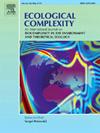Systems coupling and cross-diffusion drives complex nested pattern self-organization in predator-prey systems
IF 3.1
3区 环境科学与生态学
Q2 ECOLOGY
引用次数: 0
Abstract
The pattern self-organization of spatially extended predator-prey systems has been under intensive investigations in recent decades, but the spatiotemporal dynamics in the case of systems coupling is still lack of understanding. In this research, we focus on the pattern self-organization when two reaction-diffusion predator-prey systems are coupled together via population vertical migration. The dispersion relation and Turing instability conditions are derived, and we find the emergence of nested patterns when the dispersion relation shows two peaks. Moreover, the positive cross-diffusion enlarges parametric region for the nested patterns and enhances the pattern complexity. Numerical simulations reveal rich types of new patterns, such as white-eye pattern, nested spot pattern, and nested stripe-spot pattern. The obtained results may provide a theoretical basis for explaining the nested structures and complex patchiness phenomena occurring in aquatic ecosystems.
系统耦合和交叉扩散驱动捕食系统中复杂嵌套模式自组织
近几十年来,人们对空间扩展型捕食-食饵系统的模式自组织进行了深入的研究,但对系统耦合情况下的时空动力学仍缺乏认识。本文研究了两个反应-扩散捕食者-食饵系统通过种群垂直迁移耦合在一起时的模式自组织。推导了色散关系和图灵不稳定条件,发现当色散关系出现两个峰时,会出现嵌套模式。此外,正向交叉扩散扩大了嵌套模式的参数区域,提高了模式的复杂度。数值模拟结果显示了丰富的新模式类型,如白眼模式、嵌套斑点模式和嵌套条纹-斑点模式。所得结果可为解释水生生态系统中出现的巢状结构和复杂斑块现象提供理论依据。
本文章由计算机程序翻译,如有差异,请以英文原文为准。
求助全文
约1分钟内获得全文
求助全文
来源期刊

Ecological Complexity
环境科学-生态学
CiteScore
7.10
自引率
0.00%
发文量
24
审稿时长
3 months
期刊介绍:
Ecological Complexity is an international journal devoted to the publication of high quality, peer-reviewed articles on all aspects of biocomplexity in the environment, theoretical ecology, and special issues on topics of current interest. The scope of the journal is wide and interdisciplinary with an integrated and quantitative approach. The journal particularly encourages submission of papers that integrate natural and social processes at appropriately broad spatio-temporal scales.
Ecological Complexity will publish research into the following areas:
• All aspects of biocomplexity in the environment and theoretical ecology
• Ecosystems and biospheres as complex adaptive systems
• Self-organization of spatially extended ecosystems
• Emergent properties and structures of complex ecosystems
• Ecological pattern formation in space and time
• The role of biophysical constraints and evolutionary attractors on species assemblages
• Ecological scaling (scale invariance, scale covariance and across scale dynamics), allometry, and hierarchy theory
• Ecological topology and networks
• Studies towards an ecology of complex systems
• Complex systems approaches for the study of dynamic human-environment interactions
• Using knowledge of nonlinear phenomena to better guide policy development for adaptation strategies and mitigation to environmental change
• New tools and methods for studying ecological complexity
 求助内容:
求助内容: 应助结果提醒方式:
应助结果提醒方式:


